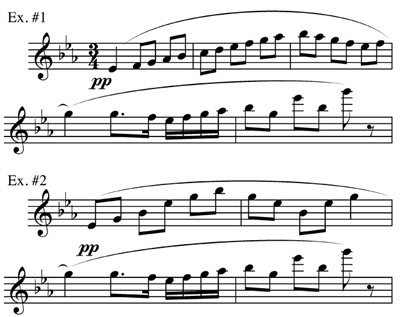Editor’s Note: This article was first published in Flute Talk in February 1982, during the magazine’s first year.
In the orchestral setting of the Minuet the flute plays continually for 94 bars; Bizet casts the flutist in four different roles – as a soloist, as an equal unison partner, as a chamber player, and as a tutti player. From bars 3 to 30 the flute plays the famous limpid melody accompanied only by the harp. At bar 31 the oboe joins the flute in unison, adding more intensity and color to the line. At bar 43 the full orchestral tutti takes over, the character of the music now becoming much more forceful, and though the flute is still playing the melody, so is most of the rest of the orchestra, and the flute no longer dominates. At the return of the opening theme at bar 56 the flutist becomes a chamber player, balancing with the alto saxophone’s poignantly beautiful countermelody. Finally, at bar 76 the flute and harp are alone once again, and the piece gradually dies away in a slow ascent to the final angelic high E flat.
Compared to the flute-piano transcription, the original orchestral version gives the flutist several advantages. The most important is in the relinquishing of his soloist role in the tutti section (bars 43-55) where he can coast with the orchestra and save his energy and concentration for the more critical last 30 bars of the piece. And in the earlier oboe unison section (bars 31-42) where there are no natural breathing places, the flutist can sneak in a number of quick breaths under the cover of the oboe line.
In the flute-piano version, you as the soloist are faced with a formidable challenge in building the long line without the aid of the orchestra. Although the piano is “replacing” the orchestra, you must maintain a strong and assertive presence in the sempre forte bars of the tutti section without being overpowered by your pianist. This does not mean that your tone has to be forced or brassy. On the contrary, if you strive for a full, round, well-centered tone, it will take actually less physical effort, and you will be better able to maintain your endurance and control in the more delicate recapitulation.
Here are some hints for proper handling of the tutti section. The accents on the quarter notes (and the eighths in bar 49) should not be made with stabbing tongue strokes. Rather, begin each one with a firm attack, follow through with a full, vibrant sound, then at the last moment execute a slight tapering, or lifting, of the tone – in other words, like a bell tone. It is usually better not to separate the quarters, although some flutists can do that with good effect. The descending 16th note scales should be played with a solid tenuto feeling, clearly tongued, but not short. Unfortunately some editions have staccato dots over these notes; none are indicated in the original. Most importantly, you must think crescendo on these scales; otherwise, they will sound weak and flabby on the third beat. Pay special attention to the placement of the Db (in bar 44 and similar places), keeping the intensity up and the pitch down.
Now, let’s take a close look at the most crucial part of the Minuet – the opening 16 bars. Your main goal here is to produce a beautifully transparent and delicate pianissimo in bars 3-10. This depends a great deal on how accurately you prepare your embouchure for placing the opening G. For most flutists that G is the dividing line between the low and high registers; that is, if you play a complete three-octave C-major scale, the middle G would be the point at which the most noticeable change of embouchure position would occur. We often assume that our embouchure changes at an equal rate during a long scale, and that it is so gradual as to be imperceptible from one note to the next. However, there is a deceptive aspect to this assumption that can cause problems if not fully understood, expecially in pianissimo playing. There should be a perceptible adjustment of embouchure when going from F5 to G5 in a pp ascending scale. (For some flutists it might be G5 to A5). This adjustment is mainly a matter of bringing the lips forward more, combined with a slight raising of the lower jaw, possibly reinforced by a discreet lifting of the head. In an case be sure that you are balancing the flute flexibly enough so that the instrument is free to move up with the jaw elevation, yet at the same time allowing the flute to maintain a firm enough support to permit the forward “traveling” of the lower lip for covering more of the embouchure hole.
As a warm-up exercise for finding the best focus for your G5, practice Exercise 1 sempre pp, avoiding the temptation of making a crescendo to the top note. After quickly memorizing this exercise, play it before a mirror, observing closely your embouchure position throughout, but with special attention to the G5. Then practice the triad exercise (No. 2) in the same way, still referring to the mirror. You are now relying on three of your senses – seeing, hearing, and feeling – to help you retain a stronger mental picture of a more perfectly controlled pp G and its satellite notes.

A third warm-up exercise could be an extension of the first two exercises: practicing a series of smooth quarter note G5s, concentrating on the delicacy of your soft tonguing strokes and making sure that you keep a consistently good tone quality. If you use vibrato, listen for an even and smooth pulsation; start your vibrato on each note without any delay.
Now let’s look at some other important considerations in this opening section. The watchword here is “legato,” and Bizet’s notation unmistakably conveys the legato message. Every one of the first six phrases is written under one long slur. Regrettably in most edited versions shorter slurs are indicated. The first phrase, for example, is often printed with a six note slur beginning with the second beat and a separate slur for the second bar. No doubt this is done partly to make it clear that the repeated G5 should be tongued (one edition even has an accent over it!), but the original slur shows us much more graphically the need for thinking legato on the second note even though we are lightly tonguing it “on the breath” – likewise at the beginning of bars 5, 7, 9, 11, 13, and 15. Another edit that can backfire is the insertion of a diminuendo in the second bar of the first phrase. A conscientious player, thinking that is the composer’s marking, will take it too seriously, and likely end up with an unnecessarily pinched and thin sound on the high G. The essence of Bizet’s pp marking is such that the same thoughtful musician would certainly play the second bar softly enough and with a nice tapered release on the high G without having to be prodded by an editor.
Smooth air flow coordinated with supersensitive embouchure changes are essential ingredients for artistic legato style, but careless fingers can easily sabotage your best intentions. The very first changing interval in the Minuet, G to F, can be dangerous. I have seen too many flutists whose right hand first finger, seemingly grown itchy from having to wait for the first two Gs to finish up, suddenly rears back with a quick windup, then slams down with a percussive, non-traditional flute sound often requested in contemporary pieces such as Varese’s Density 21.5. The first finger is a naturally strong finger, but it is also a very controllable finger, so you must teach yourself to move it down in a fast squeezing motion. The same is true, of course, for all the other intervals where fingers are going down.
A few words about intonation: take especially good care of your high Ebs. They can be terribly sharp, even in pp. We don’t always realize this because it is a good, stable sounding note, and our ear easily gets conditioned to its high pitch. One surefire way to retrain your ear for hearing this note properly (and others, too) is to practice with a strobe or electronic tuner. You may be shocked to discover that your Eb 6 can be as much as 20 cents sharp (there are 100 cents in a half-step). You can learn to correct the Eb in bar 4 quite easily, but bar 12 will take some extra effort, being twice as fast.
Finally, I suggest that you look at the upper staff of the piano score between bars 56 and 76. This is the alto sax line, and you should practice it occassionally in order to become more familiar with its countermelodic function. Ask your teacher or a friend to play the flute line while you do the sax part.






